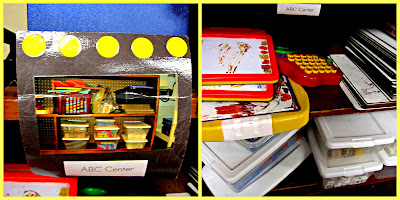We have 40 students so we need plenty of centers. Here they are!
Before we get started, you should know how it all works. The yellow dots show how many people can be at the center. Each student has a clothes pin with their name on it and they clip the pin to the dot when they want to be at a center. Student can only go to 1 center per day. My mentor teacher says that some years he has let students change centers if they would like to but that 1 per day is working right now.
Sand Tubs
This is probably our most popular center! We have another one called the rice tub and it is full of just rice and a few beans. The tubs can get a bit messy so we have a small broom and dust pan the students can use to clean up. We also tell them that if a center gets too messy and a teacher has to clean it up then we have to close it for a few days.
Bucket Toys
These are played on the ground and can be mixed up to create lots of fun games! Our students needed just a little help getting started with this center because they didn't see what all could be done with the toys. Once we gave a few suggestions, like building a boat or a super store, they took right to it.
Blocks
It's all in the name, just lots and lots of blocks! There are a few railroad kits in there too plus the barns with a handful of animals. These animal have lived in some of the most elaborate block barns I have ever seen.
Tub Toys
In the tubs are interesting things for students to explore such as keys, tiles, strings of beads, buttons, and more!
Games and Puzzles
This center has board games, matching games, and puzzles. I like to check in on students in this center because they sometimes don't know the rules to the games. Also, there are sometimes four students in this center but they are all playing different board games. I help them choose one and then play with them all for a few minutes until they are into it and understand how to take their turn. When deciding who takes the first turn, I like incorporating a little education by saying "the shortest person goes first" or "the youngest player goes first". This lets them learn a bit about each other and themselves while practicing basic math skills.
ABC Center
There are big ABC foam blocks, ABC puzzles, white boards, phonics games, and magnetic alphabet letters. In my Reading Education class we learned that it is important to let students explore letters without an academic aspect. Taking this into consideration, I don't always go to this center and help students put the letters in order or help them practice writing. Instead, I'll ask what they are doing and just see if they would like any help with what they are working on.
Home Living
Another very popular center! Students love getting out food, stuffed animals, old cameras, and old cell phones to play house with. This center needs a bit of room for the students to get everything out in. Also, this center can get very messy because a lot of people can play here and there are a lot of pieces to the center. We tell the students that if it takes too long to clean up then their mess might be too big.
Doll House
That's it, just a sweet pink doll house! I was surprised that both boys and girls like to play with the families in the home.
Reading Center
There are books, magazines, and student made books in the center. There are also whisper phones for students to practice using. The bench seat is filled with puppets and stuffed animals that the students can practice reading with or reading to.
Free Art
This is a creative place for students to draw, cut, glue, and tape! We use scrap paper and some construction paper from our recycling bend.
Cleaning Up

Our clean up procedure is the same every day so students know exactly what to do. First, a teacher blows a train whistle when there are 3 minutes left until clean up time. We ask the students to begin cleaning up if they have made a large mess. 3 minutes are put on the timer and the students keep playing. When the timer goes off, we announce that it is time to begin cleaning. We then play
our clean up song and let the students clean. When the song is over, everything should be put up and all students should be on the carpet. We also like to remind students that it is nice to help others clean up but, if you just want to tell them how to clean, then it is time to come sit on the carpet. If it takes a center a while to clean up and they are late to the carpet, we help them clean and talk to them about making smaller messes. There are a few centers that students need help putting away such as the heavy rice and sand tubs.




















